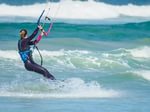Kitesurfing has to be one of the coolest sports you can do on water, but how do you get started in the first place? Where can you learn and how long does it take? To find out all about becoming a bona fide kitesurfer, we spoke to UK instructor Luke Denny, and three-time world wave champion and kitesurf coach, Kirsty Jones.
Follow these tips and this’ll be you before you know it:

What is kitesurfing?
Kitesurfing is a wind-powered watersport that uses a kite and a board to propel you across the water. Despite the name, it doesn’t have to involve wave surfing – kitesurfing can be done on mirror-flat lagoons, as well as in choppy seas or big waves. All you need is wind and water.
There’s a lot of fun and progression to be had with kitesurfing. Once you’ve mastered the basics of riding along and staying upwind, you can start going faster, jumping, doing freestyle tricks, riding waves or going on long ‘downwinders’ along the coast.
What skills do you need to get started?
Most beginners are completely new to boardsports, watersports and kite-flying, so lessons start from scratch. “Many have never flown a kite or done another watersport in their life. Some have never even put on a wetsuit,” says Kirsty Jones. For safety reasons, you should be comfortable swimming in open water.
How fit do you need to be?
You don’t need to be super-fit to kitesurf. And the kit is lightweight, so you don’t need lots of muscle strength either. However, a general level of fitness will help you progress faster, give you more stamina on the water and help you avoid injuries.

A decent level of fitness will help with learning to kitesurf
© Tom Leyden
Do you need lessons?
Yes. Any kitesurfer who respects the sport will agree that beginner lessons are essential. As well as getting you up and riding as soon as possible, a good instructor will furnish you with essential safety know-how and procedures. Without this knowledge, you’re a danger to yourself and everyone else on the water and beach.
Where can you get lessons?
You can find kitesurf schools and instructors around the globe. Most allow you to book online, and they offer anything from the choice of weekday and weekend lessons and longer packages.

Luke Denny teaching a kitesurfing class in Zanzibar
© kitesurfkings.com
Or if you want full immersion try a kitesurf camp. Kitesurf camps like Heliophora in Dakhla off the coast of west Africa, Dare2Fly in Cabarete in the Dominican Republic, or at a whole host of other camps, based everywhere from Egypt to Brazil, to Sri Lanka and the Caribbean.
How do you choose an instructor or kite school?
“All instructors must have completed a training course with a recognised body [like IKO, BKSA or VDWS],” advises Luke Denny. “But, in my opinion, it’s not good enough to simply go through the syllabi. An instructor with lots of pre- and post-qualification experience is in a better position to coach you safely and successfully. They should also have a real passion for people – without this, they’re unlikely to give you the care, attention and confidence boost that new kiters need. If you’re unsure, ask friends or other kiters for recommendations.”

IKO and BKSA qualified instructor Luke Denny
© kitesurfkings.com
An instructor with lots of pre- and post-qualification experience is in a better position to coach you safely and successfully
Luke Denny
If you’re learning overseas, make sure that you can communicate easily with your instructor. And don’t be afraid to ask about the kit you’ll be using. “Learning with new equipment that’s in excellent condition is ideal, and beginners should always be given suitable flotation vests and helmets. Learning with substandard equipment is not recommended,” Denny says.
What kit do you need for lessons?
Any decent instructor or kiteschool should provide the kit. They’ll have a range of different kites, boards and safety equipment to suit you and a full range of different wind conditions.

Most schools provide you with all the kit you’ll need
© Damián Dávila/Red Bull Content Pool
In some cases, you may need your own wetsuit – check with the school first. Sun protection is important, too, especially if you’re learning abroad – consider things like waterproof sun-cream, a rash vest (thin top to protect your arms), a cap and polarised sunglasses.
What will I learn?
A standard beginner’s course is broken down into three core elements:

A beginner’s course starts on land with lessons in kite control
© kitesurfkings.com
-
Flying a kite on land: launching, landing and kite control
-
Flying a kite in the water: body dragging, control and re-launching
-
Getting up and riding on a board
Within these elements, you will also learn about:
-
Assessing an area for safe kiting conditions
-
Understanding the wind direction, strength and gusts
-
Understanding tides, currents and hazards
-
Choosing the right equipment for the conditions
-
Setting-up, tuning and packing down your equipment
-
Safety procedures and what to do in an emergency
-
Board-starts (getting up on the board)
-
Continuous riding and speed control
-
How to stay upwind
-
Rules and rights of way on the water
How many lessons do you need before you’re up and riding?
“Most people need around 10-12 hours, or a course of three lessons to get up and riding along. Some need more – or if a student has prior board-riding experience [like wakeboarding or windsurfing], plus the right one-to-one coaching, they could potentially be independent in a single day,” says Luke.

Get ready for a fun time on the water!
© Brandon Scheid
If a student has prior board-riding experience, plus the right one-to-one coaching, they could potentially be independent in a single day
Luke Denny
“By the end of a course, you should have the knowledge and full skill set to make independent decisions and practise safely. This includes being able to assess each location and have a full grasp of weather, wind, tides and their impact, as well as knowing how to stay safe in all conditions.”
How do you know when you’re ready to stop having lessons?
”First of all, it’s essential that you’re signed off by a qualified instructor,” says Jones. “They can give you a card stating that you have reached the suitable level (level 3 for IKO) to be independent and able to rent. Secondly, even if you have been signed off by an instructor, you must feel ready yourself, and it’s always best to start with lessons whenever you feel unsure or go to a new kitesurf location.”

Dutch kiteboarder Ruben Lenten in his element
© Joel Capillaire / Red Bull Content Pool
Denny agrees: “The ultimate decision is between the student and instructor – and you should only kitesurf independently when you feel 100 percent ready.” If not, book some more coaching, supervision or do a refresher course.
What are the main challenges you’ll face as a beginner?
Building your confidence and trusting your equipment is the first hurdle for many. Being strapped to a kite can feel scary at first, but a good instructor will help you relax and show you just how safe modern kiting equipment is, provided you use it right. Some people take a long time simply building up the confidence to get started: “The biggest challenge for some is actually taking the plunge to sign up for their first lesson!” says Jones.

Learn to trust the equipment
© Nathan Polis/Red Bull Content Pool
Beginners often get to grips with kite-flying and body-dragging through the water pretty quickly, but controlling the kite in all conditions, getting up on the board and staying upwind usually takes more time, patience and practice.
Denny points to another stumbling block: “Accepting that the wind strength and wind directions can change from what’s forecast is a challenge for some. Some people struggle with this level of uncertainty so we always highlight it at the booking stage.”
What kit should you buy as a beginner?
There’s no need to buy anything straight away, as any good instructor will provide equipment. “You’ll have a better idea about what to buy once you’ve completed the course – the location you plan to kite in, for example, will make a difference to the kite size you need,” Jones advises.
“And you may outgrow some of your entry-level equipment if you buy too soon.” Beginners often learn with a seat harness, a larger board and a floatation aid. Later on, you’ll probably want to change to a waist harness, smaller board and lower-profile impact vest. “But there’s always the option to part-exchange or sell your equipment when you’ve outgrown it.”

A boarder get to grips with the rough Baltic Sea
© Sebastian Marko/Red Bull Content Pool
Many kites, on the other hand, are suitable for all levels. The most common designs have an inflatable leading edge and a bridle to attach your lines to. At a beginner level, you don’t need to worry too much about specialist designs, as modern ‘everyday’ kites usually come in standard ‘bow’ or ‘delta’ shapes (both are good for beginners). Other kite types include C-kites (lots of power and lift); hybrids (a cross between a C-kite and bow-kite); and foil kites (used for hydrofoil kitesurfing).

Preparing for some action on the waves…
© Predrag Vuckovic/Red Bull Content Pool
When you are ready to buy, use your instructor to help you choose the kite and kit that’s best for you. If you can’t afford a range of different kite-sizes, you may need to hire occasionally if the wind is too strong or too light for your own kite(s).
Kitesurf kit is lightweight and easy to transport – if you don’t have a car, you could catch a bus, taxi or carry your kit to the beach.
Beginner kit list:
-
Kite – the size you’ll need depends on the wind strength
-
Bar and lines – the right size/length to match the kite
-
Board – beginners often start on larger sizes
-
A seat or waist harness – seat harnesses are easier to learn on
-
Safety leash and safety knife
-
Floatation vest – kitesurfing vests have a gap for your bar
-
Helmet – one that’s specifically designed for kitesurfing
-
Wetsuit – if learning in cold-water destinations
Is it ok to buy second-hand gear?
Buying an older board is fine but newer is better for kites, bars and lines. Jones explains: “New equipment is always evolving, especially the kites. Equipment gets better every year. If possible, go for the latest and newest equipment you can afford, and buy from a shop or person you trust.”

Invest in a good kite
© Fabio Piva/ Red Bull Content Pool
If you have one pot of gold allocated, then the majority of that should go on the best kite and bar possible
Luke Denny
“There are often excellent deals to be had on the previous season’s kit – still new and with full warranty, this is a wise way to go,” adds Denny. “If you have one pot of gold allocated, then the majority of that should go on the best kite and bar possible.”
Do you need a license to kitesurf independently?
Generally speaking, you don’t need a licence but third party liability insurance is recommended, in case you injure another person or crash into their boat, car or expensive kitesurf kit!

Sun, sea and surfing
© Predrag Vučković/Red Bull Content Pool
Some spots do require a local permit, so you should always checking before launching somewhere new.
Are there any beginner-friendly clubs you can join?
According to Denny: “If you’ve learned on your local beach, then ask your instructor – they may be able to introduce you to other like-minded newbies they’ve taught.” Alternatively, search online for local clubs, even if you’re not based on the coast there may be groups that organise events and social activities, as well as lift shares to kitesurf spots.

Find someone at your level to kite with
© kitesurfkings.com
Finally, any tips for that first lesson?
“Try to relax and feel the wind and kite with sensitivity, not brute strength,” says Jones. “Being tense, gripping and rushing will block that intuitive feeling and progression.” Patience is important, too: “Learning to kitesurf is broken into steps – each one is an important part of the progression process, and has to be practised.”
Luke Denny qualified with both the IKO and BKSA. He runs Kitesurfkings kitesurf school in the UK and organises international training camps across the globe.
Kirsty Jones is a fully qualified kitesurf, windsurf, surf and yoga coach, and a full-time professional kitesurfer. She offers kite workshops, retreats and one-to-one coaching in various locations worldwide.





Recent Comments